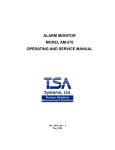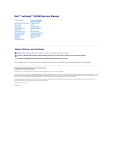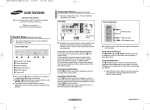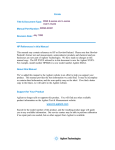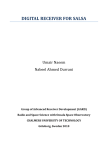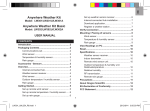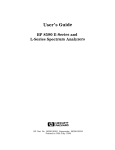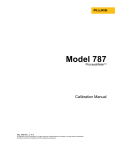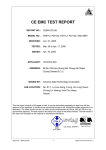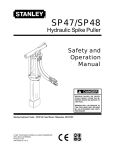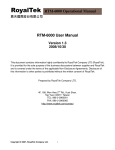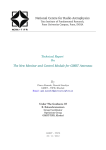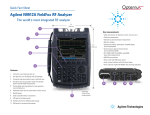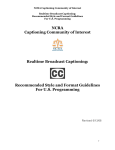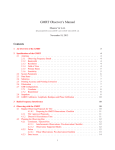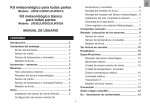Download Test Range
Transcript
National Centre for Radio Astrophysics Internal Technical Report GMRT/FEED/2014 Test Range - Standard Operating Procedures G.Sankar Email: [email protected] Revision Date Modification/ Change Ver. 1 2014 Initial Version 1 Test Range - Standard Operating Procedures G.Sankar, GMRT-TIFR. Aug.2013 1 Introduction: This report is a user manual for the NCRA Test Range. This is in sequence to the detailed design document[1] and a description of the entire- setup as given in a student’s project report[2].Chapter 2 of[2] gives an overall view of the Test range and the test equipments associated with that. Typical measurement results for three different types of feeds and frequencies are given in Ch.3 of[2]. This report is a compendium of smaller reports bearing relevance to the utilization of the Range and the measurement techniques. 2 Measurements-classification: The Range is utilized for measuring the far-field radiation patterns of feeds/antennas, over the chosen frequency range.This can be broadly divided into: • Principal plane patterns,viz., E and H planes. • Cross-polar patterns & Co-polar patterns. • Phase centre measurements. The SOPs for these sets of measurements will be referenced to the Fig.1. Fig.1 illustrates the typical geometry of the range. The transmitting and the test antenna are mounted at such heights that their line-of-sights coincide. The heights of these two are 10.5 m. With a simple azimuth directional rotation both the E and H-plane patterns can be measured. The distance between the trans.and test antennas is exactly 134.25 metres. Later during the course measurements,especially for phase centre,an alternate shorter distance was chosen. This is at 43.632 metres and the transmitting antenna was relocated; a switch-over to the longer range is easily doable. 1 The trans.antenna as shown in Fig.1, is a linearly-polarized dipole antenna. A log-periodic antenna(linear pol.) is conventionally used as the trans. antenna to cover wide range of frequencies. z Transmitting Antenna Test Antenna Azimuth rotating platform x y Figure 1: Range Geometry 2.1 Powering-up the Trans.Antenna: The longer range (134.25m.) is powered by a OF link between the two ends; details and specifications are outlined in Appendix-C. Cables losses and additional amplifiers are avoided by this novel OF link. The shorter range is powered by a low-loss (LMR400) RF cable,connecting the trans.antenna to the RF signal generator. On the receiving end, modules of amplifiers (wide-band ones), having gains of 11,20,30 dBs.are used. A portable, battery -powered amplifier is also available to place it at the trans.antenna base, having 10 dB gain.The battery inside this portable amplifier is a chargeable one. This is especially required at higher frequencies above 1.5 GHz. 2 Present test equipments at the range can support up to 3 GHz.Source antennas (trans.)- one working up to 2 GHz and another up to 3 GHz. are also available. 2.2 Test Antenna Platform: The platform is a rigid structure, mounted on a rotating disc of 800 mm. diameter, powered by a geared motor. The motor control and encoder display is part of the system. A Grey-scale absolute encoder of 13 bits resolution, with two angular limits is provided. the platform can rotate in both directions and the angular speed is controlled by a multi-turn potentiometer.The encoder’s digital readout is provided on the front panel and it can be tapped for digital data acquisition.A brief technical data of the hardware is given below: • Azimuth coverage: -200◦ to 200◦ • Azimuth rotation speed (max.): 6◦ /sec. • Encoder resolution: 0.014◦ • Encoder Model: ’Lika’ make- AS58 13/6S-6-E, Absolute enc. • Az.Drive motor: 0.5HP, 3PH. • Platform Weight : ∼ 300 kg.(without feed/antenna) 3 SOP for Principal plane Radiation Pattern Measurements: The digital encoder output and the spectrum analyzer output are connected to a NI data logger (NI USB-6009). This is can accept 8 analog inputs and has 14-bit I/O.The data acquisition is done by a LabVIEW code, whose details are given in Appendix-D. The Operating Procedures are listed below: 3 3.1 E-plane patterns: 1. Trans.antenna: Ref.Fig.1. Orient the antenna, such that the dipole arms are parallel to x -axis.(parallel to xy plane...) 2. Test antenna: Orient the same way like the trans.antenna; the testing channel/dipole arm should be parallel to x -axis. Normally a crossed-dipole/dual-orthogonal channel feed arrangement will be mounted. While one channel/port is aligned, the other channel should be terminated in a 50 Ω load. Face the test antenna towards the trans.antenna on line-of-sight.azimuth: 0◦ . 3. Power-up the signal generator & the OF-link. Do not exceed the signal power beyond +8.0 dBm. Higher power RFs can damage the OF system components. Choose the correct frequency range. Note: The Agilent Sig.Gen. : N9301A- make sure that the MOD on/off button is kept on off-mode, everytime. 4. HP 8108A Spectrum analyzer is used as the power detector. Choose a convenient frequency range, commensurate with Sig.Gen.’s freq.range.Set the default settings of RBW of 300 kHz and VBW of 3 kHz. 5. Many filters, notch /band-pass types are available at the range; they are identical pieces of the corresponding frequency band of GMRT front-end electronics.Use the correct ones based one the frequency-band; a list of available filters is given in Appendix-B. If any RFI lines are seen closer to the chosen frequency of the Sig.Gen., move away from that and choose a different frequency. 6. The received signal power should be 30 to 40 dB above noise floor;choose a combination of the modular amplifiers to realize this. Check the received power when the test antenna is facing away from the trans.antenna (azimuth: 180◦ .); here if the power is a few dB above noise floor,it should be okay for continuing the measurements. Suitable adapters,couplers are available at Range; a multi-output power supply is also available to power these amplifiers. Always check the dc voltage at the amp. power ports with a DMM. 7. When all the above conditions are met, with a slow-speed set on the rotating platform (few deg./sec.), start the data acquisition from the laptop (LabVIEW code). 4 8. Stop the rotation and data acquiring once a complete 360 deg. rotation is done. 9. The acquired data will be a 2-column vector, containing the encoder output voltage and the marker power of the Spectrum analyzer. Re-converting them to angles (a liner calibration curve for the encoder is stored in the laptop; a linear fit eqn. is used to compute the angles from the dc output voltage). 10. use any graphics software to plot the measured power against the angle-of- rotation; this is the E-plane pattern of the feed under test. 11. Repeat steps 1 thro 9 for another frequency set in the Sig.Gen.; choose intervals of tens of MHz for the frequencies,spanning the band of interest. 5 3.2 H-plane patterns: 1. Orient the trans.antenna such that the dipole arms are parallel to y -axis. (parallel to the yz plane ...) 2. Orient the test antenna - the polarization channel being tested (horizontal / vertical)parallel to y -axis. Note: Most of the dipole+reflector types of feeds, orient only the dipoles; the reflector wont be required to re-orient; in the case of aperture-type of feeds(horns, waveguides etc.) the whole feed should be re-oriented. Make sure that the orthogonal polarization channel is terminated in 50 Ω load. 3. Follow steps 3 to 7 of the above procedure for E-plane, to get the H-plane pattern. 4. Repeat steps 1 & 2 for another frequency set at the Sig.Gen. 6 4 SOP for Co-polar patterns: 1. Orient the trans.antenna, inclined 45◦ in the xz -plane. 2. Place the test antenna too inclined by 45◦ in the xz -plane. 3. Ensure the orthogonal polarization port is terminated by 50 Ω load. 4. A complete 360◦ azimuth rotation yields the co-planar pattern. Follow steps 3 to 7 given in Sec.3. Note: For circularly-symmetric radiation patterns this is average of E & H-planes patterns.[3] 5. Repeat steps 1 to 4 for another frequency set in the Sig.Gen. 7 5 SOP for Cross-polar patterns: 1. Place the trans.antenna, inclined 45◦ in the xz -plane. 2. Orient the test antenna, inclined 135◦ in the xz -plane,i.e orthogonal to the trans.antenna’s E-vector plane. 3. The orthogonal polarization port of the test antenna must be terminated by a 50 Ω load. 4. If a co-polar pattern has been measured earlier,the following step can be skipped. Otherwise,repeat step 2 of Sec.4 (i.e.orient the test antenna,inclined by 45◦ to the xz -plane.) 5. Repeat steps 3 to 7 of Sec.3. Azimuth rotation of -70◦ to +70 Ω will be sufficient to get the cross-polar pattern. 6. The cross-polar pattern’s power level should be scaled down with respect to the co-polar maximum (i.e at azimuth 0◦ ) being 0 dB. 7. Repeat steps 1 to 4 for a different frequency value. 8. The NI data logger wont be needed here; manually record the data, preferably in a spreadsheet software and plot it later. To summarize,the orientations of the trans. and test antennas are given again in the following Table. The angles in the Table are with respect to x -axis in the xz -plane. Pattern Type E-plane H-plane Co-polar Cross-polar Angle of Trans. antenna 0◦ 90◦ 45◦ 45◦ Angle of Test antenna 0◦ 90◦ 45◦ 135◦ 8 Remarks Az.scan: -180◦ to 180◦ ,, ,, Az.scan: -70◦ to 70◦ 6 SOP for Phase centre measurements: Elaborate details of the phase centre measurements and techniques are given in[4]. The method,we adopted is outlined in[2].During the initial measurement attempts by the students, the widely varying results as well as not a stable phase values forced us to locate a closer range of the trans.antenna.Appendix-A outlines the method employed and here the range distance was reduced to 43.632 m. Fig.2 shows the block diagram of the measurement set-up. Ro Transmitting Antenna Test Antenna Amp. 3 dB power divider BPF Signal Generator Vector Voltmeter Ch.A. Ch.B. Note : The RF cables connecting to Channels A & B should be of equal electrical length (phase measured at either ends should be same, within first decimal accuracy...) Figure 2: Phase centre measurement set-up 1. The trans.and the test antennas are mounted as per E-plane pattern measurements(vide.Sec.3). 2. First connect the spectrum analyzer and examine the RFI scenario; choose the relatively RFI-free band of frequencies. Note down the azimuth angle when the test antenna receives maximum RF power; make 9 a table of these peak-power for the chosen frequencies. 3. Connect the test antenna output to the Vector Voltmeter. Note: HP 8508A VVM will depict out-of-range if the input Power is ≤ -25 dB. Choose a higher power at the Sig.Gen. or add more amplifier modules. 4. Move the test antenna by ∼60◦ away from the peak. 5. Similar to the Cross-polar pattern SOP, the data logger won’t be useful for these measurements.Manually record the data in a spreadsheet form. Record the az.angle and the phase of the received signal (with respect to the input phase of the Sig.Gen.). 6. Make a quick scan of the az.angles : from −60◦ to 60◦ .If the measured phase is well within -175◦ to 175◦ , it is worth recording. If not, one will see phase-reversal occurring within the scan which would be detrimental to the phase-centre measurements and computation. Change the frequency of the Sig.Gen. by a few to tens of MHz. and do another scan; the new frequency should be free from RFI. Check-up with Step-2. If problem persists, add a coupler/cable to the trans.antenna side and scan again. 7. Rotate the test antenna by 5 to 10 sian profile of the phase values. ◦ intervals and record the data.One will see a Gaus- 8. From these set of data and knowing the line-of-sight distance, the phase centre at the chosen frequency of measurement can be calculated.If p is the phase-centre distance from the axis of rotation(azimuth), then it is given by: 2p· 1 + (R0 + x0 ) (1 − cos φ) δ = δ + 2(R0 + x0 ) (1) where, δ is the measured phase difference between the peak and chosen value. R0 is the line-of-sight diatance between the trans. and test antennas. x0 is the distance between the rotation axis and the vertical plane of the test antenna sighting, during the theodolite survey(see Appendix-A). and φ is the azimuth angular difference between the peak phase value and the chosen value; in other words, φ2 − φ1 corresponding to δ2 − δ1 , where φ1 and δ1 are the values of measured phase 10 and measured az.angle respectively for the peak of the phase-pattern. 9. Repeat the measurements so that a consistent value of the phase-centre location is arrived. 10. Change the frequency and repeat from steps 1 thro’8. References [1] G.Sankar,The NCRA Test Range for Wide-band Feeds Development( under XI Plan),Int.Tech.Report:AG-01/10,Sep.2010. [2] Vivek.D,Devendra.S,Radiation Pattern characterization of GMRT Feeds, Dept.of Avionics,IIST,Thiruvananthapuram,April,2012. [3] Per-simon Kildal,Foundations of Antennas,A Unified Approach, Studentlitteratur AB,Lund,Swedan,2000. [4] IEEE Std.149-1979,IEEE Standard Test Procedures for Antennas,John Wiley & Sons.Inc.,1979. ⋆⋆⋆⋆⋆⋆ 11 Appendix - A A New location of the Transmitting antenna - for phase centre measurements A.1 Introduction: The need to relocate the transmitting antenna, especially for phase center measurements was poitned out in the main report. This appendix illustrates the steps taken and records the theodolite survey procedures and associated computations. The most viable locations were examined and any such location on the NCRA main building’s terrace would be most suitable, since powering up the trans.antenna would be easier; the FO technique, as discussed on the main report would be dispensed with, thus reducing the hardware. A pole mounted above the water-tank on the northern segment of the building was the final choice; Fig.1 illustrates the plan view of the locations of trans.and test antenna. A.2 Survey techniques: An accurate measurement of the line-of-sight distance between the trans.antenna and the test antenna platform must be done first. This quantity will be used in the phase-centre measurements. The secondary requirement will be to exactly mark the trans.anteena height on the pole such that its lies on the horizontal plane of the test antenna’s mounting; in other words, the centres of both the antennas must coincide on the horizontal,line-of-sight. A.2.1 Step 1: A convenient point on the terrace of NCRA building was chosen first, (designated as ’T’ in Fig.1) as the theodolite station point from where clear visibility of both the trans. ans test antennas is ensured. The theodolite is positioned exactly over this point(a punch mark is placed) and the test antenna is viewed. With azimuth rotation locked on the theodolite, the elevation angles of the bottom and top 1 Water tank Theodolite Station " T " Trans.antenna. N "B " B R2 T ψ R0 R1 NCRA Building A "A " Test Antenna Platform (on the terrace of R.No.301) Figure 1: Plan view centre-lines of the square-frame of the feed-mounting are measured as angles θ1 , θ2 respectively. With the known dimension of the square frame,(k is known; ref. Fig.2) the horizontal distance R1 is given by: R1 = k tan(θ2 ) − tan(θ1 ) (1) From the measured values of θ1 , θ2 and k is known, R1 can be computed. A.2.2 Step 2: Similarly the horizontal distance R2 can be computed by an exactly similar survey of 2 points marked on the mounting pole, whose vertical distance,k′ is known. If β1 , β2 are the elevation angles of the lower and higher points on the mounting pole, then R2 is given by: R2 = k′ tan(β2 ) − tan(β1 ) 2 (2) A.2.3 Step 3: Theodolite being at the same station, next measure the azimuth angle ψ between the trans.antenna mounting pole and the test antenna platform. As shown in Fig.1, the angle ψ ,the included angle between R1 andR2 is measured. Hence the line-of-sight distance between the trans. antenna and test antenna, R0 can easily be computed, using the cosine- rule : R0 = A.2.4 q R1 2 + R2 2 − 2R1 R2 cos ψ (3) Step 4: The final step is to mark the line-of-sight on the mounting pole, so that the trans.antenna can be mounted exactly on the colinear plane to the test antenna’s centre. Refer Fig.2(the lower half;). The elevation angle, φ1 of the test antenna’s centre plane is measured. From the figure, it can be shown that, R2 tan φ2 = R1 tan φ1 (4) Angle φ2 can be computed from the above relation, as the remaining quantities are known. With the computed value for φ2 , that elevation is set and a line is marked on the mounting pole. This marked-line must coincide with the trans. antenna’s centre-line. Thus the colinearity of both the antennas is achieved. A.3 Measurements: Carl-Zeiss electronic theodolite model ELTA-3 was used for the measurement. Following are the measured parameters and the relevant computed dimensions: Step 1: θ2 = 6◦ 11′ 25′′ θ1 = 5◦ 9′ 7′′ and k = 700 mm. 3 k θ1 T θ2 A R1 1111 0000 0000 1111 0000 1111 0000 1111 0000 1111 0000 1111 Water tank & trans.antenna R2 φ R1 φ 2 1 Test antenna platform Theodolite Figure 2: Establishing the horizontal central-line 4 Therefore, R1 = 38.248 metres. Step 2: β2 = 8◦ 36′ 10′′ β1 = 7◦ 0′ 23′′ and k′ = 700 mm. Hence, R2 = 24.658 m. Step 3: The measured azimuth angle,ψ = 84◦ 54′ 57′′ So,R0 = 43.632 m. this is the line-of-sight distance between the trans.and test antennas.This value will be used for finding the phase centre of any feed being mounted. Step 4: The measured elevation angle of the test feed’s centre, φ1 = 5◦ 36′ 07′′ and therefore, ◦ 36′ 7′′ ) φ2 = arctan 38.248tan(5 24.658 and that works out to be, φ2 = 8◦ 38′ 54′′ . This elevation angle is set and a punch mark was done on the mounting pole. ⋆⋆⋆⋆⋆⋆ 5 Appendix - B B B.1 List of Filters & Amplifiers @Range: Filters: Sl.No. 1 2 3 4 5 B.2 Description 327 MHz. BPF 500 MHz. LPF 550-900 MHz.BPF 1600 MHz.LPF Mobile Notch Filter(925-950 MHz.) Nos. 1 1 1 1 1 Remarks Dual-port,cascade-able Amplifiers: Sl.No. 1 2 3 4 Device MAV-11 HMC 740 Serenza Portable Amp.- Serenza Nos. 1 1 2 1 Gain 11 dB 30 dB 20 dB 20 dB ⋆⋆⋆⋆⋆⋆ 6 Remarks +12V. supply +12V.supply +5V.supply +5V.Battery Data logging system using LabVIEW for Antenna test range G. Sankar, Sanjeet Rai Objective:To have automatic data logging at antenna test range at NCRA campus. Introduction:The GMRT system is getting upgraded to achieve seamless coverage from 30 MHz to 1600 MHz. The feed for the upgrade system is tested in antenna test range. To make RF power measurement easier, we have developed a program using LabVIEW for RF data logging and angular position measurement. Rx Tx GPIB Interface Gain Block NI 6008 USB DAQ Card Signal Generator DAQ CARD Optical Transmitter Encoder Output Test Feed Rotating Platform fiber optics cable Support structure Optical Receiver Fig1: Antenna test range setup Data Acquisition System:LabVIEW is a graphical programming language, from National Instruments. Its GUI based programming is very user friendly, it can be used for data acquisition, signal processing and for controlling system. Component used for data logging system at Antenna test range. a) b) c) d) GPIB Card NI 6008 USB DAQ Card HP 8590L spectrum analyzer Computer Every feed is designed to operate in particular range of frequencies. During the feed test time, we transmit a continuous wave signal at single frequency, which lie in the respective band of the feed using a transmitting antenna placed at far distance from the feed (acts as a receiving antenna). Feed is mounted on a rotating platform which is having encoder; it will give voltage output according to azimuth angular position of the feed. The output of the encoder is given to the USB based DAQ card which will continuously acquired angular data in terms of voltage. GPIB card has been used to acquire RF data from the spectrum analyzer; HP 8590L spectrum analyzer is having maximum 401 sweep points. It means that whatever is the span of spectrum analyzer we set using LabVIEW program, it will divide the frequency span by 400 and save the corresponding power at above sample points. Suppose if we define the frequency range from 200 MHz to 600 MHz i.e. span is 400 MHz, the processing unit within the spectrum analyzer will divide this 400 MHz span by 400 hence we will get 1 MHz. This means that the RF power at 200 MHz, 201MHZ, and 202 MHz etc up to 600 MHz will get logged during every acquisition cycle. During testing time we do E and H plane measurement. The feed placed on rotating platform will scan the transmitting antenna in azimuth plane to get E and H plane data. During scanning, our program will continuously record the RF power received by the feed and encoder voltage. The setting for the spectrum analyzer are RBW=300 KHz, VBW=3 KHz and Sweep time= 500ms. Below is the LabVIEW code that we have used for data logging. Fig2: Spectrum data logging code control panel. Fig3: Spectrum data logging code front panel. In the above LabVIEW code we define the spectrum analyzer visa address, resolution bandwidth video bandwidth, sweep time, start and stop frequency, acquisition delay time etc.





















